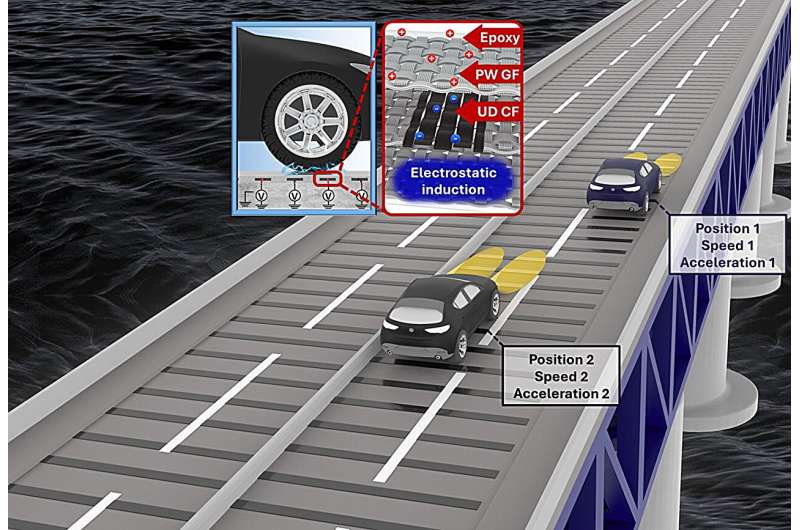
A breakthrough in traffic monitoring technology has been achieved by a research team affiliated with UNIST. The team unveiled sensors that can monitor traffic and road conditions in real-time, while strengthening buildings and road structures.
These advanced sensors, constructed from carbon fiber composites, enable applications in traffic condition monitoring, traffic accident detection, and traffic accident prediction through real-time tracking of vehicle position, speed, and acceleration.
Professor Young-Bin Park and his research team in the Department of Mechanical Engineering at UNIST developed a structural self-powered FRP-TES grid that exhibited superior electrical and structural stability compared to conventional TES systems. The study is published in the journal Nano Energy.
Experimental results revealed that the FRP, composed of carbon fibers, glass fibers, and epoxy, generated electrical energy as tires passed over it. Furthermore, even after subjecting the FRP-TES grid to 10,000 tire passes, no discernible voltage degradation was observed, and its mechanical properties exceeded those of conventional TES systems.
Carbon fiber composites offer excellent mechanical properties, weighing about a quarter as much as iron and possessing 10 times greater strength. These composites are ideal for widespread use in various applications due to their advantages over traditional iron-based materials.
The team demonstrated the versatility of their technology by manufacturing a composite-based self-powered sensor on a large scale and verifying its effectiveness through a vehicle driving test. They also explored the use of friction charging principles, which enable the sensor to respond sensitively to environmental changes.
By analyzing the changes in electrical signals generated by friction charging sensors, researchers can accurately track tire movement and calculate its size.
According to Dr. Seongwan Lee, the lead researcher, “Our self-powered sensor has great potential not only for monitoring traffic conditions but also for responding to and predicting traffic accidents.”
Professor Park added that the sensor’s applications extend beyond academia, with potential uses in traffic volume management, vehicle weight and speed measurement, and industrial settings.
“Future research will aim to integrate the triboelectric mechanism of FRP with Structural Health Monitoring (SHM) using carbon fiber to implement intelligent infrastructure capable of traffic monitoring and structural health monitoring,” noted the research team.
“This advancement is expected to extend to various fields, including robotics.”
More information:
Seonghwan Lee et al, Self-powered triboelectric sensor based on a carbon fiber/glass fiber/epoxy structural composite for efficient traffic monitoring, Nano Energy (2024). DOI: 10.1016/j.nanoen.2024.109818
Ulsan National Institute of Science and Technology
Carbon fiber composite sensors offer solution for efficient traffic monitoring (2024, July 22)
retrieved 22 July 2024
from https://techxplore.com/news/2024-07-carbon-fiber-composite-sensors-solution.html
part may be reproduced without the written permission. The content is provided for information purposes only.

A breakthrough in traffic monitoring technology has been achieved by a research team affiliated with UNIST. The team unveiled sensors that can monitor traffic and road conditions in real-time, while strengthening buildings and road structures.
These advanced sensors, constructed from carbon fiber composites, enable applications in traffic condition monitoring, traffic accident detection, and traffic accident prediction through real-time tracking of vehicle position, speed, and acceleration.
Professor Young-Bin Park and his research team in the Department of Mechanical Engineering at UNIST developed a structural self-powered FRP-TES grid that exhibited superior electrical and structural stability compared to conventional TES systems. The study is published in the journal Nano Energy.
Experimental results revealed that the FRP, composed of carbon fibers, glass fibers, and epoxy, generated electrical energy as tires passed over it. Furthermore, even after subjecting the FRP-TES grid to 10,000 tire passes, no discernible voltage degradation was observed, and its mechanical properties exceeded those of conventional TES systems.
Carbon fiber composites offer excellent mechanical properties, weighing about a quarter as much as iron and possessing 10 times greater strength. These composites are ideal for widespread use in various applications due to their advantages over traditional iron-based materials.
The team demonstrated the versatility of their technology by manufacturing a composite-based self-powered sensor on a large scale and verifying its effectiveness through a vehicle driving test. They also explored the use of friction charging principles, which enable the sensor to respond sensitively to environmental changes.
By analyzing the changes in electrical signals generated by friction charging sensors, researchers can accurately track tire movement and calculate its size.
According to Dr. Seongwan Lee, the lead researcher, “Our self-powered sensor has great potential not only for monitoring traffic conditions but also for responding to and predicting traffic accidents.”
Professor Park added that the sensor’s applications extend beyond academia, with potential uses in traffic volume management, vehicle weight and speed measurement, and industrial settings.
“Future research will aim to integrate the triboelectric mechanism of FRP with Structural Health Monitoring (SHM) using carbon fiber to implement intelligent infrastructure capable of traffic monitoring and structural health monitoring,” noted the research team.
“This advancement is expected to extend to various fields, including robotics.”
More information:
Seonghwan Lee et al, Self-powered triboelectric sensor based on a carbon fiber/glass fiber/epoxy structural composite for efficient traffic monitoring, Nano Energy (2024). DOI: 10.1016/j.nanoen.2024.109818
Ulsan National Institute of Science and Technology
Carbon fiber composite sensors offer solution for efficient traffic monitoring (2024, July 22)
retrieved 22 July 2024
from https://techxplore.com/news/2024-07-carbon-fiber-composite-sensors-solution.html
part may be reproduced without the written permission. The content is provided for information purposes only.









